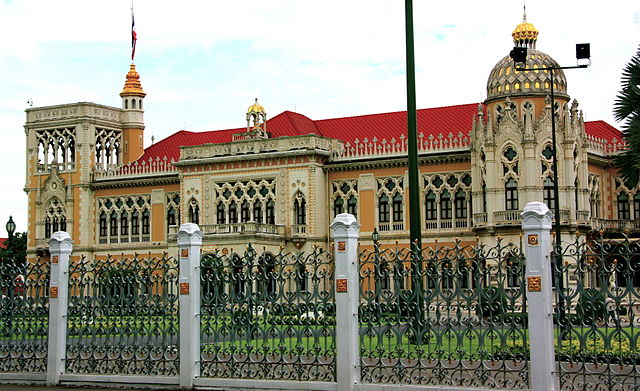
Mockery of Fiscal Decentralization: The “Intergovernmental Transfer” System in Thailand
In early July 2013, the City of Detroit’s historic bankruptcy filing came as a rude shock to the entire world, especially to Thailand where its Auditor General revealed in 2012 that local government debt, if not taken care of soon, may become out of control in the next few years. In late July 2013, the hysteria over potential local insolvency in Thailand was magnified by Beijing’s seismic move to audit local authorities nationwide for fear of excessive debt accumulation. The American and Chinese local debt conundrums are reminiscent of Brazil’s 1990s national financial trouble caused by overgenerous bailouts for state and local authorities. Back in Thailand, based on the Auditor General’s estimates in 2012, the country’s public debt level would become 42% of GDP if all local government debts were included. The alarming local debt statistics have triggered much excitement in the Ministry of Interior which possesses the constitutional mandate to supervise local government operations, but whose performance has thus far been under par. 1 This time however, the ministerial officials rapidly moved to tighten up fiscal control over the country’s local government landscape.

Reflecting the above context, this article seeks to unveil the peculiar process of decentralization in Thailand where local autonomy is limited in every aspect in spite of the constitutional guarantee. However, instead of discussing Thailand’s decentralization in broad brush strokes like in previous studies, it will dissect the specific grant system used by the national government to keep the grassroots communities on a short leash.
Thailand is one of the least transparent and most inequitable intergovernmental transfer systems in Asia
Theoretically, the local expenditure patterns should not deviate much from the local revenue streams. If the locally collected revenues are inadequate, the intergovernmental equalization transfer mechanism can be put in place to assist the cash-strapped and economically disadvantaged communities. 2 Granted, no perfect intergovernmental transfer system exists in the world, not even in the economically advanced federal countries. However, despite the constitutionally mandated decentralization reform, Thailand remains heavily centralized with one of the least transparent and most inequitable intergovernmental transfer systems in Asia. 3 Whereas the scope of Thai local governments’ discretion and function is narrow, their local revenue sources are even narrower, 4 depending largely on tax receipts from commercial activities. The centrally imposed local tax structure leaves the vast majority of Thai localities in the rural agricultural areas with virtually nothing to tax. Even with limited responsibility, these rural communities encounter fiscal stress every year and, in finding their way out of the fiscal problem, must depend on intergovernmental fiscal transfers.

The Thai intergovernmental transfers are divided into the general grant and specific grant. While general grants allow local authorities to determine what and how to spend the allocated funds, specific grants are truly specific. The Ministry of Interior, not the local authorities, decides what and how to spend the specific intergovernmental transfers. Constrained by the Interior Ministry’s stringent spending rubrics, Thai local governments are reduced to mere implementers of centralized policy decisions. This would not have sabotaged decentralization reform, had specific grants not constituted the large part of local government budgets around Thailand. In reality, specific grants are the fiscal arteries of Thai local government. 5 For a large number of local communities, more than half of their annual revenues come from specific grants alone. In this context, although local autonomy is constitutionally enshrined, the Ministry of Interior’s specific grant system curtails much of the local government’s fiscal and decision-making autonomy.
Not only does the specific grant system undermine local self-determination, its inconsistent grant allocation criteria have instigated the clientelistic relationships between the national politicians, national bureaucrats, and local government officials. 6 Since the decentralization reform unfolded, it has become widely known among the Thai local officials that the amount of specific grants for each locality depend much more on personal political connections than pure economic and technical reasons. In most cases, lobbying for specific transfers requires the mastery of reaching kickback agreements with the national politicians and bureaucrats. However, not all local governments in Thailand possess such political prowess and hence are left with one last option to finance their public services: borrowing from commercial banks and the Municipality Promotion Fund (MPF).
Thailand needs an overhaul of its national government agencies
Detroit’s bankruptcy and potential insolvency in Chinese local governments do more harm than good for the Thai localities. As the Interior Ministry proceeds to constrict local government borrowing, concern surfaces over the transparency and consistency of any criteria and procedures that will be bequeathed upon local governments in the future. Thus, in moving forward with local empowerment through decentralization, Thailand needs an overhaul of its national government agencies, as well as a brand new menu of local capacity-building strategies that make life easier for the local communities.
Tatchalerm Sudhipongpracha
College of Local Administration
Khon Kaen University, THAILAND
Kyoto Review of Southeast Asia, Young Academics Voice, September 2013
Notes:
- Wongpredee, Achakorn. (2007). Decentralization in Thailand, 1992-2006: Its Effects on Local Politics and Administration. Ph.D. Dissertation. Kyoto, Japan: Kyoto University. Kamnuansilpa, Peerasit & Wongthavasu, Supawatanakorn. (2003). Capacity Development for Tambon Administrative Organizations in Northeast Thailand (in Thai). Khon Kaen: Prathammakhan. ↩
- Shah, Anwar. (2006). “A Practitioner’s Guide to Intergovernmental Fiscal Transfers.” In: Boadway, Robin W. & Shah, Anwar (eds.). Intergovernmental Fiscal Transfers: Principles and Practices. Washington, DC: World Bank. ↩
- Kurata, Masamitsu & Yukio Ikemoto. (2012). “Decentralization and Economic Development in Thailand: Regional Disparity in Fiscal Capacity and Educational Decentralization.” In: Uchimura, Hiroko (ed.). Fiscal Decentralization and Development: Experiences of Three Developing Countries in Southeast Asia. New York: Palgrave Macmillan. ↩
- World Bank. (2005). East Asia Decentralizes: Making Local Government Work. Washington, DC: World Bank. ↩
- Patamasiriwat, Direk. (2012). “Fiscal Inequality and Grant Allocation: Provincial Analysis of Thailand’s Local Government Finance.” In: Kamnuansilpa, Peerasit & Brereton, Bonnie (eds.). Local Governments in the Global Context. Khon Kaen, Thailand: College of Local Administration Press. ↩
- Mutebi, A. M. (2005). “Government and Citizen Engagement at the Local Level in Thailand: Nan Municipality’s “Roundtables” and “Expert Panels”.” Asia Pacific: Perspectives V, Special Issue: Redemocratizing Southeast Asia through Citizen, Corporation, and Government Alliances (August): 16-28. ↩
